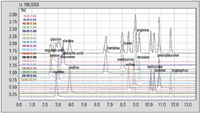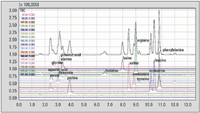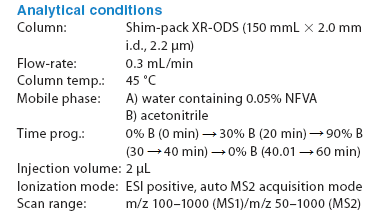Analysis of Amino Acids in Foods using LC–MS
"Amino acid" is a generic term referring to organic chemistry compounds that have amino and carboxyl groups. There are many known types of amino acids with natural origin. In addition to being the basic unit comprising proteins (one of the main constituents of living organisms), they are the raw material necessary for synthesis of physiologically active low-weight molecules such as neurotransmitters. Even as individual units they possess various types of physiological activity. They are researched widely in the fields of medicine and food. Recently, they are being widely used in health foods such as supplements.
"Amino acid" is a generic term referring to organic chemistry compounds that have amino and carboxyl groups. There are many known types of amino acids with natural origin. In addition to being the basic unit comprising proteins (one of the main constituents of living organisms), they are the raw material necessary for synthesis of physiologically active low-weight molecules such as neurotransmitters. Even as individual units they possess various types of physiological activity. They are researched widely in the fields of medicine and food. Recently, they are being widely used in health foods such as supplements.
In general, analysis of amino acids is conducted using HPLC systems equipped for cation exchange column separation, post- or pre-column derivatization and fluorescence detection. Analysis objectives include the analysis of composition such as determination of ingredients in foods and structural analysis of proteins, in addition to diagnosis of errors of metabolism of amino acids.
Following the demand for fast and sensitive analysis of amino acids, an LC–MS method is described in this application note. Because amino acids exist as zwitterions (they become both positively and negatively charged depending on the pH of the aqueous solution in which they are present) the electrospray ionization (ESI) method is most suitable for analysis. LC–MS analysis was conducted for each of the amino acids with [M+H]+ as the detection ion.
Figure 1 shows the positive ESI mass spectra of glycine, L-leucine and L-tryptophan standard samples. When using an acidic mobile phase, the protonated molecules [M+H]+ are observed as reference peaks in all of the amino acids.

Figure 1: The positive ESI mass spectra of glycine, L-leucine and L-tryptophan standard samples.
Figure 2 shows the SIM chromatogram of a standard mixture of amino acids. Separation of the 18 amino acids, required for conducting quantification, was completed in about 12 minutes.

Figure 2: The SIM chromatogram of a standard mixture of amino acids.
Figure 3 shows the results of analysis of amino acids in soy sauce. The soy sauce was diluted by a factor of 250 and was then passed through a membrane filter.

Figure 3: The results of analysis of amino acids in soy sauce.
This LC–MS method is applicable for free amino acid analysis in such materials as soft drinks containing amino acids, sake, vinegar, plant materials (tea extracts) etc.


Shimadzu Europa GmbH
Albert-Hahn-Str. 6-10, D-47269 Duisburg, Germany
tel. +49 203 76 87 0 fax +49 203 76 66 25
E-mail: shimadzu@shimadzu.eu
Website: www.shimadzu.eu

New Study Reviews Chromatography Methods for Flavonoid Analysis
April 21st 2025Flavonoids are widely used metabolites that carry out various functions in different industries, such as food and cosmetics. Detecting, separating, and quantifying them in fruit species can be a complicated process.
Analytical Challenges in Measuring Migration from Food Contact Materials
November 2nd 2015Food contact materials contain low molecular weight additives and processing aids which can migrate into foods leading to trace levels of contamination. Food safety is ensured through regulations, comprising compositional controls and migration limits, which present a significant analytical challenge to the food industry to ensure compliance and demonstrate due diligence. Of the various analytical approaches, LC-MS/MS has proved to be an essential tool in monitoring migration of target compounds into foods, and more sophisticated approaches such as LC-high resolution MS (Orbitrap) are being increasingly used for untargeted analysis to monitor non-intentionally added substances. This podcast will provide an overview to this area, illustrated with various applications showing current approaches being employed.

.png&w=3840&q=75)

.png&w=3840&q=75)



.png&w=3840&q=75)



.png&w=3840&q=75)















